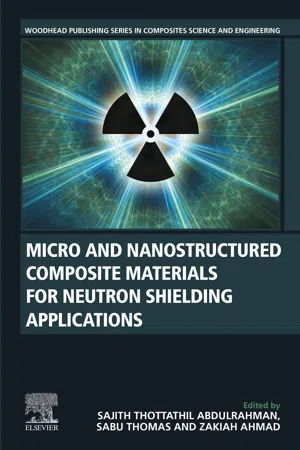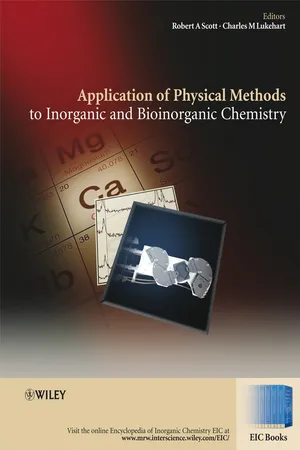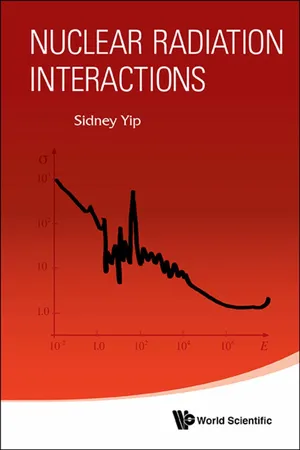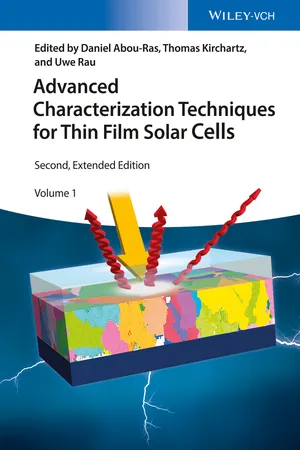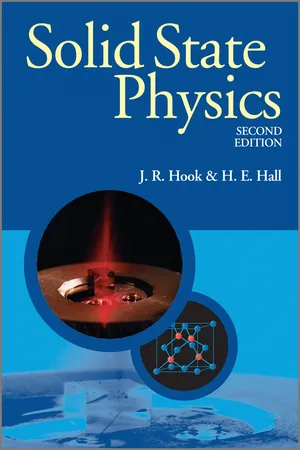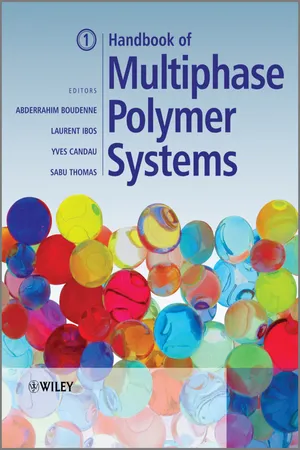Physics
Neutron Scattering
Neutron scattering is a technique used to study the structure and dynamics of materials at the atomic and molecular level. Neutrons are directed at a sample, and the way they scatter provides information about the sample's composition, crystal structure, and magnetic properties. This method is valuable for research in physics, chemistry, materials science, and biology.
Written by Perlego with AI-assistance
Related key terms
Related key terms
1 of 4
Related key terms
1 of 3
11 Key excerpts on "Neutron Scattering"
- Sajith Thottathil Abdulrahman, Sabu Thomas, Zakiah Ahmad(Authors)
- 2020(Publication Date)
- Woodhead Publishing(Publisher)
13 ].By making use of the wave property of neutrons, it was established that neutrons can undergo diffraction in a manner very similar to that of X-rays. It obeys the Bragg equationn λ = 2 d sin θ(13.1)where λ is the de Broglie wavelength of neutrons, d is the distance between adjacent planes of scattering particles, θ is the angle between the incident neutron source and the plane of the scattering particles, and n is an integer called the order of the diffraction (see Fig. 13.1 ). In a scattering experiment, neutrons of a particular wavelength are selected by means of diffraction at some selected angles from a monochromating crystal, which can appropriately filter out unwanted diffraction orders. Such an incident wave is characterized by a momentump i= ℏk i(13.2)whereis the associated wave vector, with λ i being the wavelength of the initial/incident beam. Such a beam is directed to the sample either directly or after chopping into pulses. The sample scatters the beam in some specific manner depending on its structure, dynamics, isotopic, and magnetic properties. The wavelength of the final/scattered beam λ fk i=2 πλ i- Robert A. Scott, Charles M. Lukehart, Robert A. Scott, Charles M. Lukehart(Authors)
- 2013(Publication Date)
- Wiley-Interscience(Publisher)
hν . These frequencies are usually dependent on the propagation direction in the crystal, the specific crystal structure, and its atomic composition. Rotational, vibrational, and librational motions can also be effectively studied with neutrons. Finally, using high surface-to-volume materials, neutrons can be employed to investigate surface phenomena. In the following sections, some of the mathematical formalism of the Neutron Scattering technique will be used and several examples that are aimed at illustrating the power of the technique, with the goal of stimulating additional interest and further reading in more advanced and specialized monographs and journals.2.3 Neutron Scattering Formalism
In a typical Neutron Scattering experiment, the intensity of the neutrons scattered from a beam incident on a sample is recorded. Usually, the scattering process will involve a deflection of the incident neutrons identified by a change in the wave vector,k, of the beam, and denoted by the scattering vector Q =ki −kf , where the subscripts i and f denote the incident and final directions, respectively. In addition to the change in wave vector, the scattering can also involve a change in the energy, E , of the neutrons. The magnitude of this energy change is usually associated with some dynamic process in the sample and hence we can represent that as an angular frequency, ω , such that E = hω . The scattered intensity measured in a neutron experiment is proportional to the dynamical structure factor, S (Q ,ω ) and hence is a function of both Q and ω . S (Q ,ω ) represents the Fourier transform of the temporal and spatial fluctuations of the atomic (spin) density in a normal (magnetic) Neutron Scattering process. There are many comprehensive discussions of Neutron Scattering formalism and the reader is directed to such monographs written by Marshall and Lovesey,5 Lovesey,6 Bacon7 and Squires8- eBook - ePub
Experimental Methods in Polymer Science
Modern Methods in Polymer Research and Technology
- Toyoichi Tanaka(Author)
- 2012(Publication Date)
- Academic Press(Publisher)
is particularly useful for polymer science.2.2.2 Neutron Scattering AND CROSS SECTION
Neutrons are scattered by nuclei because of nuclear force. Because the range of the nuclear force is very short (10−13 –10−12 cm) and the size of nuclei is much smaller than that of an atom (≈10−8 cm), most of materials are “very dilute” for the “eye” of neutrons, as schematically illustrated in Figure 2.3 . Let us consider a case in which a flux of neutron Φ0 is irradiated by an object. According to Lambert’s law, the transmitted flux Φ is obtained byFigure 2.3 Comparison of the sizes of neutrons and atoms for Neutron Scattering.(8)where σT is the number rate of neutrons that collide with the atoms, N is the number of atoms in the sample volume V, and x is the path length of the object. σT is called the total cross section and consists of the absorption σa and the scattering cross sections σ, respectively;(9)If the scattering is isotropic, σ is given by(10)where b is the scattering length. The scattered intensity for an assembly of atoms of number N can be calculated by taking account of the phase of the scattered waves in the context of the Born approximation [18](11)where Ω is the solid angle, andbiand r i are respectively the scattering length and the position vector of the atom i ;〈…〉 denotes the average; and (d σ/d Ω) is called the differential cross section and q is the momentum transfer given by(12)where q is the magnitude of the momentum transfer (or scattering vector) and θ is the scattering angle. The q - eBook - ePub
- Sidney Yip(Author)
- 2014(Publication Date)
- WSPC(Publisher)
PART 2
Unit Processes of Nuclear Radiation Interactions
Passage contains an image
9
Neutron Scattering
Throughout this book, Neutron Scattering plays a special role — it is the first example of nuclear radiation interaction. We would like to know everything about this interaction, from the nature of the interaction, the kinematics and dynamics, to the various cross sections that are of interest to us, and finally the effects of Neutron Scattering in the broader study of neutron transport in nuclear systems. In this chapter we confine our discussions to only elastic scattering (no excitation of the target nucleus). Even so there are additional significant aspects of Neutron Scattering on which the reader can be usefully informed by consulting with the recommended references, not only just those cited in this chapter, but also those cited in Chap. 13 .9.1NEUTRON-PROTON SCATTERING
We take up the problem of Neutron Scattering in hydrogen which is well-known for its significance in the science of neutron interactions with matter, as well as in a broad range of nuclear technology applications. The scattering cross section of hydrogen in the form of water has been widely measured to be 20.4 barns over a range of energy from thermal energy up to keV. Our interest here is to apply the method of phase shift analysis discussed in Chap. 7 to this problem. We see very quickly the s -wave approximation (the condition of interaction at low energy) is very well justified in the neutron energy range between 1 and 103 eV. The scattering-state solution (E > 0) gives us the phase shift or equivalently the scattering length. This calculation yields a cross section of only 2.3 barns, which is considerably lower than the experimental value and clearly indicates something important is missing. The reason for the discrepancy lies in the fact we have not taken into account the spin-dependent nature of the n -p interaction. The neutron and proton spins can form two distinct spin configurations, the two spins being parallel (triplet state) or anti-parallel (singlet), each giving rise to a corresponding scattering length. When this is taken into account, the new estimate is quite close to the experimental value. The conclusion is therefore n -p - eBook - ePub
- Robert E. Masterson(Author)
- 2017(Publication Date)
- CRC Press(Publisher)
Neutron Scattering experiments can be used to understand the atomic structure of many solids and liquids. Neutron Scattering experiments are used to determine the exact positions, motions, and magnetic moments of atoms by investigating how neutrons collide with them and then measuring the change in the kinetic energy and the momentum of particles going into and out of the reactions. Experimental data obtained from these scattering experiments can then be used to infer the internal structure of the atom or molecule that is being investigated.In Chapter 2 , we mentioned thatneutrons are subatomic particles that cannot be focused into narrow beams or “steered” using electric and magnetic fields because they do not possess an electric charge. However, they are produced in nuclear reactors and nuclear accelerators in very large numbers, and they can still be focused to a certain extent by providing a narrow channel or “tube” between the source of the neutrons and the target which is to receive them (see Figure 3.17 ). If enough shielding is placed around the tube, many of the neutrons hitting the shield will be absorbed or deflected in another direction, and the only neutrons that remain become a narrow beam of unattenuated neutrons. Machines that generate neutron beams are calledneutron beam generators. A picture of a commercial neutron beam generator is shown in Figure 3.17 . Most neutron beam generators are small devices that weigh no more than 100 lb (about 40 kg). When a nuclear reactor is used to generate one of these beams, the neutron beams normally originate from a number of preferred channels or “ports” that emanate from the reactor vessel itself. (The exact configuration of these ports depends on how the reactor is designed.)Normally, research reactors are designed with these ports, while power reactors are not.FIGURE 3.17 - Daniel Abou-Ras, Thomas Kirchartz, Uwe Rau(Authors)
- 2016(Publication Date)
- Wiley-VCH(Publisher)
Chapter 15 X-ray and Neutron Diffraction on Materials for Thin-Film Solar CellsSusan Schorr, Christiane Stephan, Tobias Törndahl, Rene Gunder and Daniel M. Többens15.1 Introduction
In order to understand natural and artificially produced materials, a detailed understanding of their crystal structures is required. This information is a basis for research in physics, chemistry, biology, and materials science. Among the various experimental methods, neutron and X-ray (photon) scattering have become key techniques of choice. Both techniques are complementary. In X-ray scattering, it is almost exclusively the electrons in atoms which contribute to the scattering, whereas neutrons interact with the atomic nuclei. This has an important consequence: The response of neutrons from light atoms (such as hydrogen or oxygen) is much higher than for X-rays, and neutrons easily distinguish atoms of comparable (or even equal) atomic number (see Figure 15.1 ). Due to the fact that neutrons interact with atoms via nuclear rather than electrical forces and nuclear forces are very short range (of the order of a few Fermis, i.e., 10−15 m), the cross section for such an interaction is very small. The size of a scattering center (nucleus) is typically 105 times smaller than the distance between the centers. As a consequence, neutrons can travel large distances through most materials without being scattered or absorbed. Thus, neutrons penetrate matter much more deeply than X-rays.While Neutron Scattering provides insights into the crystal structure with high resolution, X-ray scattering has the advantage that (due to a larger scattering cross section) measurement durations are usually much shorter, compared with Neutron Scattering. Additionally, lab-scale X-ray sources are broadly available.15.2 Diffraction of X-Rays and Neutron by Matter
Most of all inorganic, solid materials can be described as crystalline. When X-rays or neutrons interact with a crystalline substance, coherent elastic scattering may occur, which is also termed diffraction.- eBook - ePub
- J. R. Hook, H. E. Hall(Authors)
- 2013(Publication Date)
- Wiley(Publisher)
CHAPTER 12
Scattering of neutrons and electrons from solids
We became very excited about this experimental challenge and the opening up of new possibilities. Astonishingly it took us a couple of weeks to realise that not only would we have a local spectroscopic probe, but that scanning would deliver spectroscopic and topographic images, i.e. a new microscope.—Gerd Binnig and Heinrich Rohrer—on the discovery of the scanning tunnelling microscope—Nobel prize address, 198612.1 INTRODUCTION
In section 11.2 we presented a general approach to the problem of elastic scattering of waves by crystals and showed how measurements of the directions and intensities of diffracted beams enable the structure to be determined.† Experimental arrangements used in x-ray diffraction have already been described in Chapter 1. In this chapter we describe methods used to study the scattering of neutrons and electrons. We explain how inelastic scattering of neutrons can be used to provide information on the energy–momentum relation for the excitations in a solid, such as phonons and magnons. Finally we give a brief survey in section 12.6 of a number of important techniques, in most of which electrons are used, for studying the surfaces of solids.12.2 COMPARISON OF X-RAYS, NEUTRONS AND ELECTRONS
12.2.1 Interaction of x-rays, neutrons and electrons with atoms
There are important differences in the way x-rays, neutrons and electrons interact with the atoms in a solid. X-rays are scattered primarily by the atomic electrons, and the atomic scattering factor f (see Eq. (11.1) ), which describes the strength of the scattering, therefore increases steadily with increasing atomic number (Fig. 12.1 ); this makes it difficult for x-rays to detect light atoms, particularly in solids in which there are also much heavier atoms. Because of destructive interference between radiation scattered by different parts of the electron cloud, f - eBook - ePub
Nuclear Engineering Fundamentals
A Practical Perspective
- Robert E. Masterson(Author)
- 2017(Publication Date)
- CRC Press(Publisher)
Finally, it requires us to define what are called neutron cross sections for scattering, fission, and absorption. These cross sections will be presented to the reader in Chapters 4 and 5. Hence a cross section can be thought of as a convenient way to model the collective behavior of large numbers of neutrons when it becomes impractical to model the behavior of each of them individually. The neutron diffusion equation is then used to describe the behavior of these neutrons in an Eulerian reference frame. Almost all nuclear science and engineering is performed in this reference frame. Now let us make some final observations about Neutron Scattering angles and Neutron Scattering probabilities. 3.32 Scattering Angles and Scattering Probabilities In practice, not all neutrons scatter off an atomic nucleus in exactly the same way. Free neutrons and other nuclear particles follow scattering probability distributions when interacting with a nucleus on a nuclear scale. Over large numbers of these collisions, the angular distribution of the scattered neutrons P(θ) can be plotted as a function of the kinetic energy E of the incoming neutron and the atomic mass A of the target nucleus. In this section, we would like to briefly discuss how these scattering probability distribution functions can be defined. We would then like to demonstrate how they can be used to define another important variable, which is called the Neutron Scattering cross section. The Neutron Scattering cross section can then be used to define the diffusion coefficient in the neutron diffusion equation, which was discussed in Section 3.31 above. Neutron Scattering cross sections are among the most important variables in all of nuclear science and engineering, and so we would like to take some time to describe how they can be deduced from the outcome of a Neutron Scattering experiment - eBook - ePub
- Abderrahim Boudenne, Laurent Ibos, Yves Candau, Sabu Thomas, Abderrahim Boudenne, Laurent Ibos, Yves Candau, Sabu Thomas(Authors)
- 2011(Publication Date)
- Wiley(Publisher)
Multiphase polymer systems are characterized by correlations on mesoscopic length scales. Accordingly mostly scattering methods at low momentum transfer are used to gather information about these systems. The most important techniques in this context are small angle Neutron Scattering and, for additional surface sensitivity, reflectometry or gracing incidence scattering.18.2.4.1 Neutron Small Angle ScatteringConventional small angle Neutron Scattering (SANS) works in transmission whereas neutron reflectometry (NR) uses a reflection geometry. Accordingly, SANS probes the bulk properties of a sample whereas in NR the surface is studied. For both techniques the radius of the Ewald sphere or the amount of the incident wave vector, for example for a wavelength of 0.5 nm , is huge in comparison to the reciprocal lattice vectors, typically smaller than 1 nm−1 , under investigation. This allows the excitation of several Bragg reflections at the same time. It is important to note that for SANS the Born-approximation, assuming one single scattering event, holds, whereas neutron reflectivity is a dynamical or multiple scattering effect.In contrast to the scattering theory described above where the Schroedinger equation was solved for a single particle potential for small momentum transfers the details of the atoms become invisble for the scattered neutron. The phase shift between the scattered waves from neighboring atoms is small and smearing of the phase due to the finite coherence of the beam does not allow atomic resolution. Accordingly, over a certain (the coherence volume of the neutron beam) area averaged potential is probed. For example V (r ) for atoms enclosed in a defined volume has the following form:(18.34)where and - eBook - ePub
Developments in Surface Contamination and Cleaning - Vol 5
Contaminant Removal and Monitoring
- Rajiv Kohli, Kashmiri L. Mittal(Authors)
- 2012(Publication Date)
- William Andrew(Publisher)
Apart from image distortions which are not easy to correct, this feature restricts them essentially to the investigation of surfaces. In addition, investigations always have to be conducted under vacuum. X-rays, on the other hand, while being able to penetrate more deeply into matter, exhibit variations of sensitivity covering several orders of magnitude over the periodic table, impeding their use for many systems involving particular combinations of elements. Neutrons, in principle, are not subject to these drawbacks. Moreover, the Neutron Scattering process is sensitive to isotopic composition even for nuclei having the same atomic number. This feature allows the use of isotopic replacement, which does not change the chemical properties of the sample but provides a method to enhance or suppress particular parts of an object by recording a hologram. About a decade ago, a detailed analysis suggested how to transfer and adapt holographic conceptions to the neutron case [9]. Novel experimental setups were put forward and quantitative estimates showed that neutron holography was not easy to realize but nevertheless should be feasible. In what follows, we present an overview of the progress made in this field since. 2 Basic Concepts Classical diffraction techniques, widely used in the investigation of structural properties of condensed matter for approximately 100 years, are based on the evaluation of intensity patterns produced by the interference of those parts of a primary beam of photons (light, X-rays) or particles (electrons, neutrons) which are scattered by the object under investigation. The non-interacting part of the primary wave field is not taken into account but is usually removed by a beam catcher. By contrast, holography makes use of the interference of the scattered parts of the wave field with the primary beam itself - eBook - ePub
- Toyoko Imae, Toshiji Kanaya, Michihiro Furusaka, Naoya Torikai, Toyoko Imae, Toshiji Kanaya, Michihiro Furusaka, Naoya Torikai(Authors)
- 2011(Publication Date)
- Wiley(Publisher)
eq. (I.1.15) . This way magnetic multilayers can serve as powerful neutron beam polarizers by reflecting neutrons with one spin direction with much higher probability than those with the other (Mezei and Dagleish, 1977). A detailed description of the art of neutron reflectometry can be found in Chapter 1.I.1.8 Scattering, Interference, and CoherenceWe now turn our attention to the evaluation of the interference processes that can occur between neutron waves scattered by different atoms. This is the central subject for the study of matter on the atomic scale by actually any radiation (even including electron microscopy, where the atomic scale resolution often apparently achieved by direct imaging is also the result of shrewd processing and reconstruction). When particle waves scattered on different atoms are superposed, the interference between these waves is determined by the optical path length differences between waves scattered at different atoms. The optical path is defined as the real geometrical distance in the direction of wave propagation multiplied by the wave number of the radiation, cf. in eq. (I.1.4) . A change of the optical path comparable to unity implies substantial modification of the wave by a shift of its phase by a radian. Hence, the high sensitivity of neutron wave interference to distances comparable to 1/k = λ/2π offers us a spatial resolution capability not accessible by direct imaging methods.Let us consider the optical paths for scattering on a point-like object (nucleus) at a position , by comparing it to the optical path for a scattering object at r = 0. The incoming radiation will be considered as a plane wave with wave vector and the outgoing radiation as spherical waves from each scattering center with a wave number , cf. eq. (I.1.9) . Here we assume that the detection point is at a very large distance compared to the distance between the scattering points; therefore, the outgoing radiation arrives to the detector practically as a plane wave with wave vector , with a direction determined by the position of the neutron detection. As shown in Figure I.1.4 , the optical path difference between the two spherical waves scattered at the origin and
Index pages curate the most relevant extracts from our library of academic textbooks. They’ve been created using an in-house natural language model (NLM), each adding context and meaning to key research topics.
Explore more topic indexes
Explore more topic indexes
1 of 6
Explore more topic indexes
1 of 4
